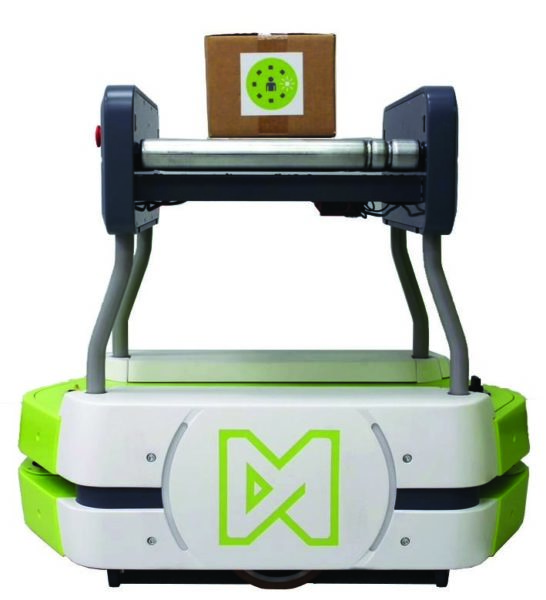Built on a standard base vehicle outfitted with a choice of attachments, the latest Matthews Autonomous Mobile Robot applications are featured in ProMat Booth S1631
The newest version of Matthews Automation Solutions’ Autonomous Mobile Robot (AMR) is on display in Booth S1631 throughout MHI-sponsored ProMat in Chicago’s McCormick Place, April 8–11, 2019. The self-navigating vehicle will be shown with two different attachment options that address multiple applications, including materials movement and picking assistance.
“Matthews AMRs provide greater flexibility for dynamic environments, such as omni-channel order fulfillment operations,” explains Dave Remsing, Vice President of Market Development for Matthews Automation Solutions. “The bots manage repetitive work—such as handling and transporting cartons or totes—so associates can focus on value-added tasks, like picking and sorting orders.”
Further, Remsing adds, when fully integrated with the rest of the operation, a fleet of AMRs boosts material flow and inventory throughput while eliminating the need for manual handling or forklift traffic.
Traveling autonomously throughout an operation, the Matthews AMR uses natural feature navigation (also known as contour or landmark navigation). It deploys 2D laser scanning of fixed points within the environment, mapping its path instead of utilizing reflectors, tape or other targets to maneuver. This function enables the robot to be a quick, low-cost solution that easily accommodates physical changes in the facility layout (unlike target-based systems that need new reflective marks located, fixed and surveyed to adapt to operational modifications). Its ability to avoid obstacles and self-determine its own route also makes the Matthews AMR ideal for more dynamic warehouse and manufacturing facilities.
Customize base robot with application-specific attachments
Depending on the selected attachment configuration, Matthews AMRs support activities such as receiving, putaway, picking, sorting and order fulfillment.
For materials movement, the Matthews AMR is outfitted with a motor-driven roller (MDR) conveyor attachment on top. This enables it to either complement existing conveyor systems, or be deployed in areas where conveyor installation may not be physically or financially feasible. The powered rollers allow a carton or tote to glide smoothly onto and off of the attachment when the AMR reaches its destination. Applications include load transfer to powered or non-powered conveyors, to pallets for cross-docking, or to picking and sortation areas for pick-to-light, put-to-light, automated loop or case sorters and more.

To increase picking productivity by optimizing zone, batch and cluster picking without the need for conveyors, sleds or picking carts, the Matthews AMR is equipped with a light-directed picking attachment that carries multiple totes or shipping cartons. The bots transport the order totes while the operators make picks within their zones. Each tote may represent a specific customer, store or department within a store. To start the process, the robot positions itself in an active pick zone for easy operator access. Pick-to-light or put-to-light modules direct the operator to the next stock keeping unit (SKU) required for picking.
Simultaneously, lights on the AMR’s cluster picking attachment illuminate under each container requiring that item and indicate the quantity needed of that SKU. The operator completes the picks/puts and presses the task complete button to tell the software the task is finished. The bot travels to the next required SKU for the order and the process repeats until all picks in that zone are complete. The AMR then moves to another zone for additional picks as required by the order set.
Once all picks are complete, the bot navigates its picked cartons to pack-out stations for order consolidation, packaging and shipment. Meanwhile, other AMRs continue to work with operators in their picking zones and the pickers continue to work, uninterrupted. This synchronized interaction between pick and put systems, robots and operators enables employees to concentrate on their core task—order picking.
“These bots complement more traditional material handling automation, such as picking systems, put walls and warehouse execution software,” shares Gary Cash, Vice President of Solution Development for Pyramid, a Matthews Automation Solutions brand. “They can either augment conveyor, carts and sleds, or provide a more agile pick routing alternative. By delivering more integrated, end-to-end automation, Matthews AMR-assisted material handling applications enable users to achieve higher levels of productivity.”











